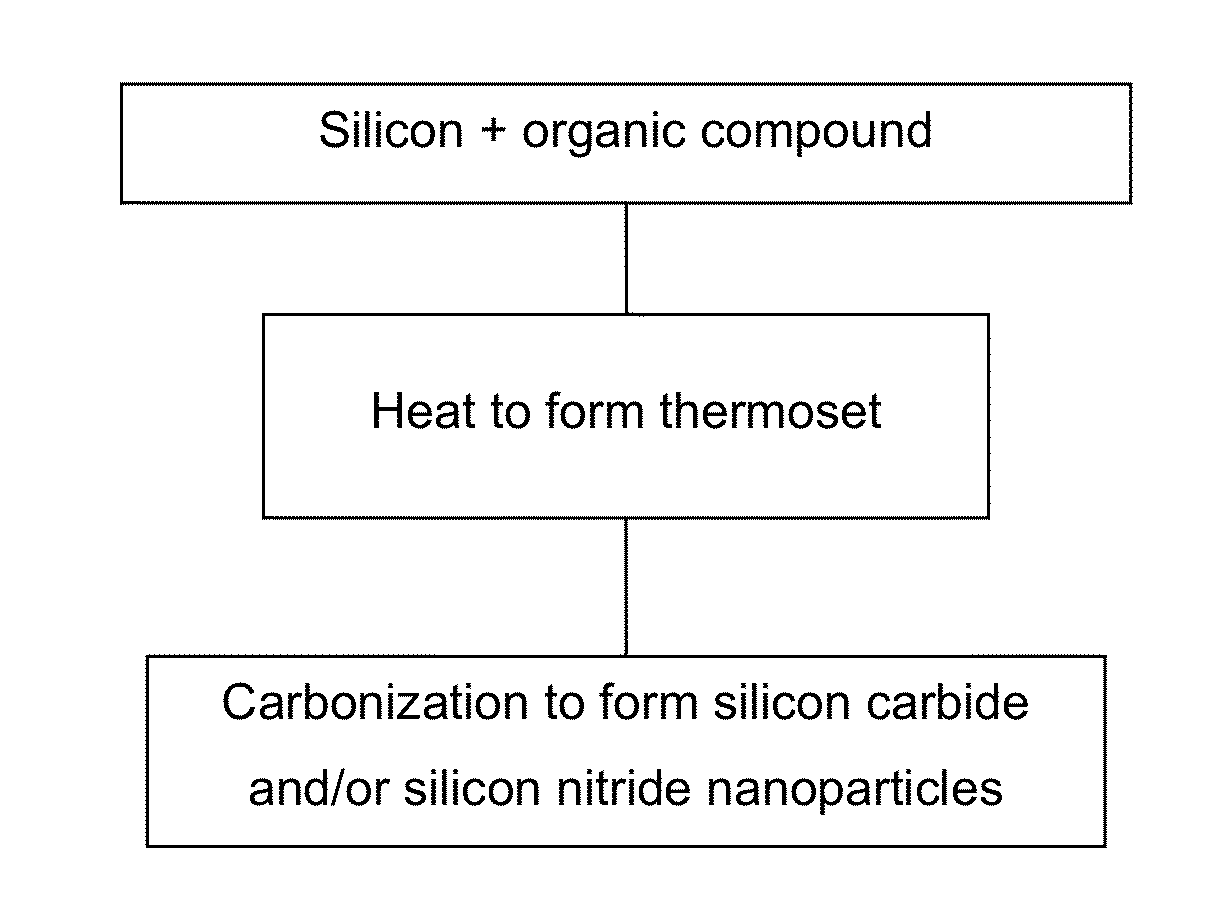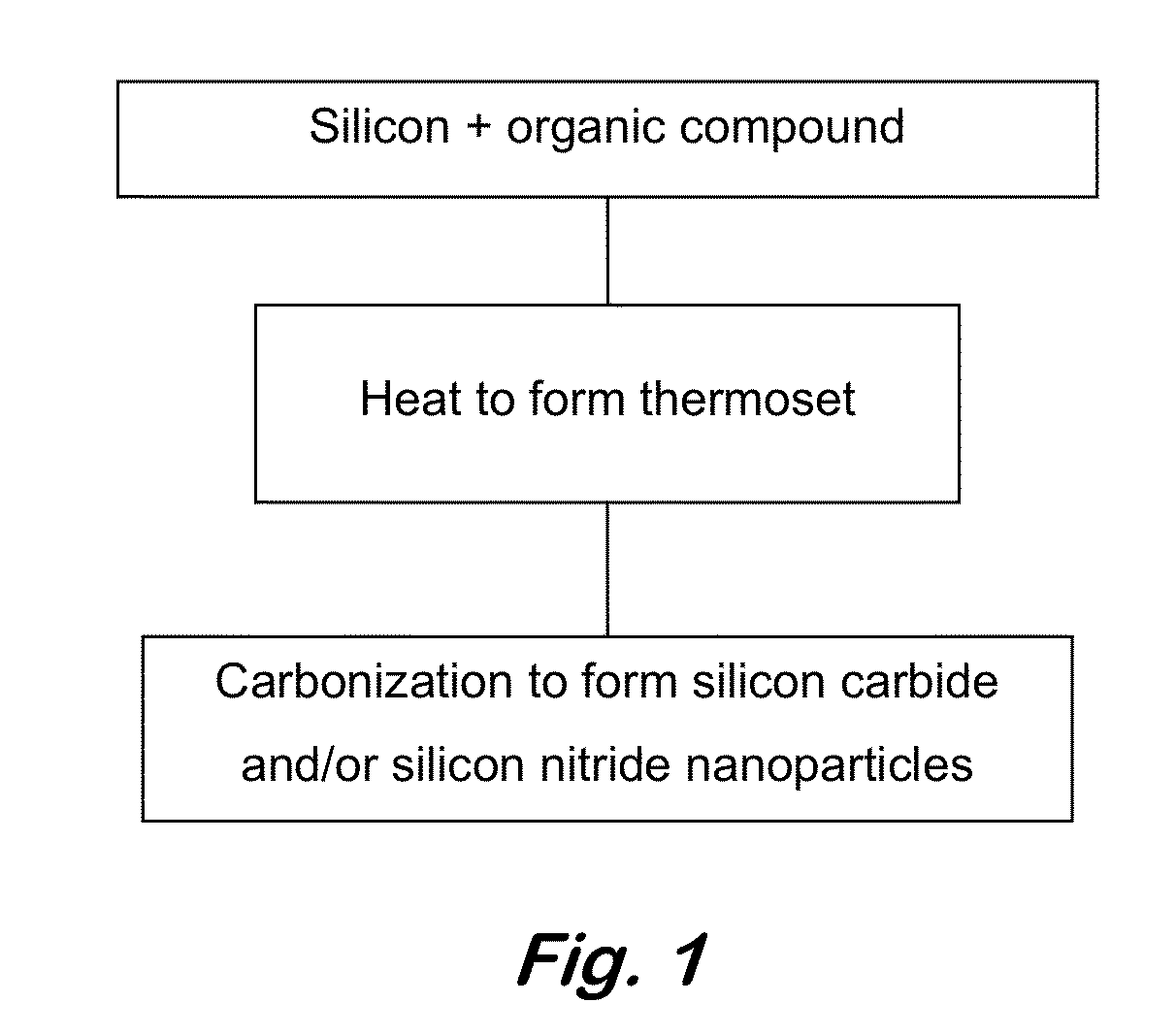Formation of silicon carbide-silicon nitride nanoparticle carbon compositions
a technology of silicon carbide and silicon nitride, which is applied in the direction of carbides, other chemical processes, manufacturing tools, etc., can solve the problems of brittleness of silica, poor quality material, low impact resistance and low fracture toughness
- Summary
- Abstract
- Description
- Claims
- Application Information
AI Technical Summary
Benefits of technology
Problems solved by technology
Method used
Image
Examples
example 1
Formulation of Precursor Composition of TPEB and Silicon Powder (1 to 5 μm Particle Size) in Molar Ratio of 1 to 50
[0063]TPEB (0.250 g; 0.523 mmol) and silicon powder (1 to 5 μm particle size) (0.732 g, 26.1 mmol) were thoroughly mixed and used as the precursor composition for the formation of refractory nanoparticle SiC embedded or bonded with the excess of silicon that behaves as a matrix material. The ratio of the two reactants can be readily varied by the described formulation method.
example 2
Conversion of Precursor Composition of TPEB and Silicon Powder (1 to 5 μm Particle Size) in Molar Ratio of 1 to 50 to Polymeric Thermoset Solid in an Argon Atmosphere
[0064]A sample (75.2450 mg) of the precursor composition of Example 1 was weighed into a TGA ceramic pan, packed thoroughly, flushed with flow (110 cc / min) of argon for 20 minutes, and then heated at 5° C. / min to 250° C. and held at this temperature for 1 hr to consolidate to a shaped thermoset solid from reaction of the ethynyl units of TPEB.
example 3
Conversion of Polymeric Thermoset Solid to Shaped Silicon Carbide-Silicon Matrix Solid Ceramic Composition by Heating to 1450° C. Under an Argon Atmosphere
[0065]The solid polymeric thermoset of Example 2 was heated under a flow (110 cc / min) of argon at 3° C. / min to 1200° C. and held at this temperature for 1 min followed by heating at 1° C. / min to 1415° C. and holding at this temperature for 1 hr and at 1 ° C. / min to 1450° C. and holding at this temperature for 1 hr. The resulting solid ceramic sample retained 90.45% of the original weight. XRD analysis showed the formation of pure silicon carbide nanoparticles / nanostructures embedded in a matrix of crystalline Si nanostructure.
PUM
| Property | Measurement | Unit |
|---|---|---|
| Temperature | aaaaa | aaaaa |
| Temperature | aaaaa | aaaaa |
| Temperature | aaaaa | aaaaa |
Abstract
Description
Claims
Application Information
 Login to View More
Login to View More - R&D
- Intellectual Property
- Life Sciences
- Materials
- Tech Scout
- Unparalleled Data Quality
- Higher Quality Content
- 60% Fewer Hallucinations
Browse by: Latest US Patents, China's latest patents, Technical Efficacy Thesaurus, Application Domain, Technology Topic, Popular Technical Reports.
© 2025 PatSnap. All rights reserved.Legal|Privacy policy|Modern Slavery Act Transparency Statement|Sitemap|About US| Contact US: help@patsnap.com



